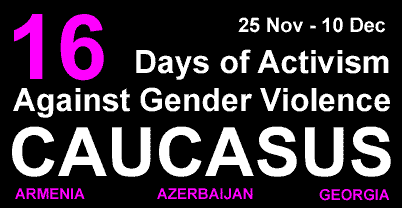|
|
|
|
|
PRESS
RELEASE
BREAKING THE CULTURE OF SILENCEThe
UN Secretary-General, Kofi Annan has called it an epidemic, and
largest global meeting of women - the 1995 Fourth World Conference
on Women in Beijing highlighted the scourge that preys on women
and girls of all nations, of all cultures. It is gender-based
violence — and it continues to grow, encouraged by the silence
surrounding the issue and excused by reference to cultural norms.
The
1995 Fourth World Conference on Women in Beijing adopted a
Platform for Action, which declares that "Violence against
women is an obstacle to the achievement of the objective of
equality, development, and peace." Violence
against women is a complex phenomenon deeply rooted in the way
society is set up — cultural beliefs, power relations, economic
power imbalances, and the masculine ideal of male dominance.
Gender-based violence occurs in all societies and is the
social, psychological and economic subordination of women and it
has thrived unnoticed because there was no global recognition of
its existence until the past twenty years.
In
adopting the 1993 Declaration on the Elimination of Violence
Against Women, the UN General Assembly defined the problem as
"any
act of gender-based violence that results in, or is likely to
result in, physical, sexual, or psychological harm or suffering to
women, including threats of such acts, coercion, or arbitrary
deprivation of liberty, whether occurring in public or private
life." Such
violence occurs within the home or in the wider community and
women are vulnerable to this violence at all stages of life, even
before they are born, through female infanticide. The
UN estimates that over 60 million girls are ‘missing’
due to ‘son preference’. Women
face many threats even within their home and work place and
especially in war and conflict situations.
Threats range from child abuse, prostitution, physical
violence, psychological abuse, sexual harassment to harmful
practices excused as ‘traditional culture’ such as forced
early marriage, widow burning, and female genital cutting.
According to the World Health Organization (WHO), at least
one in every five of the world's The
Beijing Platform for Action adopted in 1995 sets out an agenda for
elimination and prevention of gender-based violence. However the
solutions are not simple as one of the key requirements is the
breaking down of stereotypes and negative attitudes toward women.
The media, as major purveyors of society's images, can play
a key role in achieving this goal. Refusal
to recognize the problem is a barrier to its solution. In most
countries a deeply entrenched culture of silence surrounds cases
of violence against women, making it difficult to get a true
picture of its extent. One of the main reasons is that
gender-based violence mostly occurs within families, inside homes,
and out of sight, in what is regarded as the ‘private’ sphere.
Such violence is underreported and often deliberately disguised by
both the survivors and the societies in which they live. At
the 1994 International Conference on Population and Development in
Cairo, nearly 180 countries recognized the role of violence in the
definition of women's reproductive health, which "includes
the right of all to make decisions concerning reproduction free of
discrimination, coercion, and violence …" International
conventions and legislation are just beginning to be translated
into action at a level that can effectively protect women — the
level of families, communities, and even national governments.
These global initiatives are a beacon of hope for women and men
who are working together to pull the issue out of the shadows and
to clearly define gender-based violence as a problem for society. The
need to produce a legislative initiative on the issue brings to
light the major discrepancies between countries with extremely
advanced programs and those without. The
differences refer not only to the financial aspects, -lack of
funds for initiating and sustaining assistance programs,
consulting offices, and therapy and psychiatric treatment for
victims and aggressors, but also to the cultural aspects.
According to Pierre-Henri Imbert, Director of the Commission of
Human Rights of the Council of Europe, "Democracy within a
relationship reflects the degree of democratic development at the
level of the entire society." Domestic
violence has been defined as a pattern of coercive behavior. It
could be physical, verbal, emotional, or sexual, perpetuated
usually by men against women to maintain power and control. Although
the scope and pattern of battering may vary from country to
country and region to region, research has established that
battering, if kept silent, continues to escalate.
Battering produces emotional as well as physical scars.
While the bangs, bruises, or knife wounds fade, the emotional
injuries slowly kill the spirit. In
1996, the World Health Assembly passed a resolution calling for
public health interventions to combat violence. CHILDREN
BECOME VICTIMS Violence
absolutely impacts on children even if they do not say anything. A
child who has undergone or witnessed violence may become
withdrawn, anxious or depressed on one hand. On the other hand,
the child may become aggressive and exert control over younger
siblings. Psychologists agree that boys usually carry out the
aggressive form of behaviour and as adults, may beat their
spouses. Children
who witness abuse in their homes experience what is called potent,
long-playing memory tapes: This is what daddies do to mommies;
it's okay for men to hit women; so through a child’s eyes
violence equals love. According
to Pida Ripley, “the best way to love a child is to give
him a safe home environment”. WomenAid International is a humanitarian aid and development agency which also campaigns for women’s rights. WomenAid has been working in the CIS region, Central Asia and the Caucasus since 1994 and its CIS regional office is based in Tbilisi, Georgia. For further information please visit the WomenAid International website at www.womenaid.org Further
details of activities organized by NGO partners can be found on
the specially created Caucasus
16 Days
website:
www.womenaid.org/16days Prepared
for Caucasus 16 Days of Activism Against Gender Violence 2001.
Copyright WomenAid International 2001 © |



